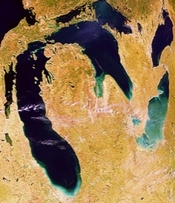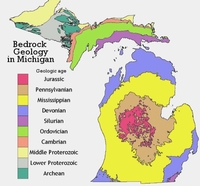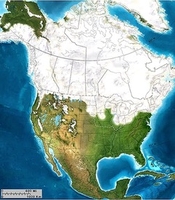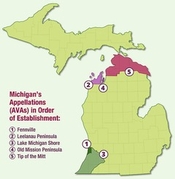
The geologic forces that created the state of Michigan today stretch back to the very roots of the North American continent. The geologic structure of Michigan is a circular basin – a bowl that gathered sediments for nearly 400 million years. Because of its symmetry and exposure of bedrock around the basin margins, the Michigan Basin is well-known in geology circles as an archetype of a sedimentary basin. Following the depositional phase, the rocks endured a long period of erosion, with rivers cutting valleys in the softer rocks.

The erosional phase continued until about two million years ago. This is the beginning of the Pleistocene Epoch, the great ice age that transformed the topography of the northern part of the continent and covered the entirety of Michigan. During the Pleistocene, masses of glacial ice, thousands of feet thick, moved south from Canada. Continental glaciers can pulverize rock and move massive amounts of sediment. The glacial ice was channeled through the existing river valleys, scouring and deepening those valleys in the softer rocks. The semi-circular shape of Lakes Michigan and Huron that surround the state owe their arcuate geometry to the underlying geology.
There were several advances and retreats of the continental glaciers, each both embellishing the erosion and obscuring the sediments of the previous advance. The last advance ended about 11,000 years ago with the ice mass halfway across Indiana and Ohio. The glacial retreat occurred in fits and starts, with multiple re-advances and retreats of the ice. With each gyration, glacial debris was piled up in what is known as end moraines. Ultimately, the ice mass melted and left the state covered in hundreds of feet of glacial drift – a mix of sand, gravel and clay beds formerly entrained in the ice.

The happy result of the geologic history for vintners is the presence of large bodies of water that moderate the climate in this northern latitude. The mélange of glacially dumped soils has allowed vintners to find a proper balance of sand, gravel and clay to support their vines.
There have always been vines in Michigan. According to accounts from French explorers of the late 1600’s, they encountered abundant native grapes along the Detroit River and made wine from those grapes. South of Detroit, on the western shore of Lake Erie, the River Raisin was named for the multitude of vines growing along its banks. By the mid 1800’s, a wine industry had been established here. Around the same time, a farmer named A.B. Jones is credited with the first vineyard planting in southwestern Michigan. In 1856, he purchased a small farm near Lawton and planted a few grapevines, which grew to several hundred vines as fruit sales grew. Jones named his farm “Pioneer Vineyards.”
As in other parts of the United States, grape growing and winemaking grew until Prohibition became the law of the land. Combined with vine disease, that was the death knell for the wineries around Lake Erie. The southwestern Michigan grape growers were able to survive Prohibition by selling grapes to the Welch’s Grape Juice Company, which established a production facility there. Prohibition also resulted in wineries being established across the Detroit River in Canada where a thriving trade in contraband was established.
With the repeal of prohibition in 1933 wineries were again permitted to operate, but that coincided with the Great Depression, and the price of grapes dropped dramatically. To protect Michigan growers, the state passed a law that assessed a four cent per gallon tax on wine from Michigan grapes, but fifty cents per gallon (about $10 adjusted for inflation) for wines from elsewhere. That, plus the hard economic times, led to decades of lackluster production. In the 1956 edition of American Wines and Wine-Making, author Philip Wagner noted that there was a winegrowing district in the southwestern part of the state and wrote: “Michigan wine-makers enjoy a substantial tax advantage, and as so often happens the relative immunity from competition has weakened the incentive to strive for quality. …. Little if any Michigan wine is exported to other states.”

By the 1960s, however, Michigan vintners begin to rethink the grapes used for wine production and the styles of wine preferred by consumers. Growers began to experiment with plantings of French/American hybrids like Marechal Foch and de Chaunac. In 1969, Tabor Hill Winery in southwestern Michigan made the first documented plantings of vitis vinifera by planting Chardonnay and Riesling.
In the north, Northwestern Michigan College Library Director Bernie Rink planted northern Michigan’s first hybrid varieties on the Leelanau Peninsula in 1965. He would expand his plantings and establish the now-closed Boskydel Vineyards, leading the way for the now widespread wineries on Leelanau. In 1974, Edward O’Keefe Jr. brought in German winegrowing expertise and established Chateau Grand Traverse on an Old Mission Peninsula cherry orchard. He planted the first vitis vinifera in northern Michigan with Riesling and Chardonnay. Across the bay on Leelanau, Larry Mawby planted his Elm Valley Vineyard in 1976 – the beginning of today’s Mawby Sparkling Wines.
Today there are some 140 wineries in Michigan and the industry has made impressive progress in the last 40 years. At least three thousand acres of vineyard are now devoted to wine production and there are now five AVAs in the state. Few wine consumers outside of the state are familiar with these:
Fennville AVA, established in 1981, was the third AVA in the US. It is located close to Lake Michigan and includes 75,000 acres in southwestern Michigan.
The Lake Michigan Shore AVA was established in 1983 and encompasses the Fennville AVA within its 1.28 million acres. It stretches some 45 miles inland from the lake shore but still benefits from the moderating climate effects of the lake.
The Leelanau Peninsula AVA in northwestern Lower Michigan was established in 1982. Although its 75,000 acres are very far north, Lake Michigan to the west, Grand Traverse Bay to the east and Lake Leelanau in the middle all moderate the temperatures.
Old Mission Peninsula AVA is on a narrow arm of land 19 miles long and maximum of 3 miles wide between Leelanau and the mainland. It became an AVA in 1987 and encompasses just over 19,000 acres. Surrounded by Grand Traverse Bay, it benefits from the frost protection of the lake waters.
The Tip of the Mitt AVA covers a broad swath of the northern lakeshore of lower Michigan. The name refers to the mitten shape of the state and the AVA includes some 1.7 million acres, although vineyards are widely scattered across its breadth. It is Michigan’s newest AVA, approved in 2016.

I have sampled excellent wines from many areas of Michigan and the quality continues to improve as vintners identify better sites and better techniques to get the most out of their grapes. Riesling leads the way and there are many wines, primarily from Leelanau and Old Mission that have impressed tasters with their purity and racy style. Many wineries make a range of Rieslings with varying degrees of residual sugar, so be careful to find the style you prefer. Other Michigan white grapes that show promise are Pinot Blanc, Gewürztraminer, Chardonnay, Grüner Veltliner, Muscat and Pinot Gris. Hybrid varieties like Vignoles, Traminette and Vidal can also yield pure and refreshing wines.
Sparkling wines are important in Michigan. The naturally high acid levels of the northern climate offer ample opportunity for base wines that will support the second fermentation and transformation to sparkling. Red wines are made throughout the state as well. The southwestern AVAs are warm enough to support quality Syrah, Cabernet Franc, Merlot and even Cabernet Sauvignon. The northern AVAs tend to concentrate on Pinot Noir and Blaufränkisch. Many wineries devote part of their grapes to rosé production, at times with delicious results.
There is much to discover among Michigan wines. If you are traveling through the state, you will easily find them on retail shelves and restaurant wine lists. Outside of Michigan, availability is sparse. A search of the internet can lead you to wineries that can ship to most other states. Your investigation can pay handsome rewards.
